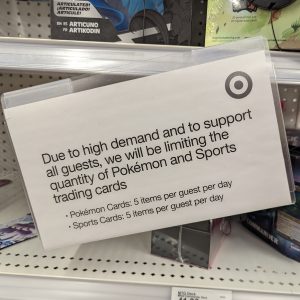If you were a child sometime in the last three decades, you’ve likely had some sort of a connection to the cultural juggernaut that is the Pokémon franchise. An intellectual property so well known that Microsoft Word has autocorrected my spelling of the word Pokémon three times now. My personal connection to the franchise has persisted throughout my life. As a seven-year-old, I scrounged together change to buy a pack of the trading cards at the local 7-11. Later in life, I almost got robbed in a park while playing Pokémon Go at 2 AM in 2016 (true story).

Most recently, I’ve begun to see Instagram ads for products not associated with Nintendo that draw from the vast pool of Pokémon nostalgia to push their products. One service in particular, called Pika Pika by Arianna, caught my eye. It’s a commission-based service that offers to draw your pet and insert them into a Pokémon card. The card looks like it could be used in the actual game. The picture of the pet is drawn in the style of a Pokémon. Typically, on every Pokémon card, there is a picture of the Pokémon and a list of abilities or moves that it can do. The abilities that are listed on the Pika Pika card are creatively adapted in accordance with your pet’s personality. I have two pets myself, and I’ve thought about using this service on more than one occasion.
Being new to the world of intellectual property, I wondered how this didn’t violate Nintendo’s IP rights. Nintendo, as it stands, is no slouch when it comes to protecting their IP. They’ve pursued aggressive legal action in the past to target unauthorized uses of their IP. So, I’m surprised that services like this are gaining so much traction.

Once I took the IP Survey class with Professor Ho, I began to consider if such works could be protected from copyright litigation. Trademark liability is another potential issue since so much of the iconography from Pokémon is used in the creation and promotion of these cards which could cause unknowing parties to assume that this service is associated with Nintendo and Pokémon. But that could be its own post entirely.
Copyrights and Pokémon
Copyrights protect “works of authorship” like drawings and videogames that are original (i.e. not copied from another), fixed in some sort of tangible medium of expression (i.e. paper, electronic), and meet a minimum threshold of creativity (this is typically a low bar). With copyright protection comes certain rights . Among these rights is the right to create derivative works. Derivative works use elements from or elements based on already existing works to create a new work. These can be works such as sequels, adaptations, revisions, etc.

An example within the Pokémon franchise is the Pokémon trading card game itself. The trading card game was actually derived from the video game in 1996. Further derivatives from the videogame were the manga, the tv show, plushies, candies… too many to list. Nintendo is the copyright holder of the original work, the Pokémon videogame, and thus has this right to produce such derivative works. Derivatives of the Pokémon videogame have made the franchise the highest-grossing media franchise of all time. A cool 109 billion dollars in revenue, beating Mickey Mouse and Star Wars by more than 20 billion dollars.
Fair Use and Unauthorized Derivatives
If someone other than Nintendo creates a derivative work from Pokémon without the company’s blessing, they could be liable for violating Nintendo’s copyright. However, just because this artist is producing derivative works from Pokémon does not make them automatically liable. The author of these derivative pet cards could have what is called a Fair Use defense to protect them from liability. The Fair Use Doctrine helps facilitate free expression and promote creativity that would otherwise be unlawful if not authorized. To have a valid fair use defense, we look at four different factors enumerated in the statute that the courts consider holistically:
- the purpose and character of the use, including whether such use is of a commercial nature or is for nonprofit educational purposes;
- the nature of the copyrighted work;
- the amount and substantiality of the portion used in relation to the copyrighted work as a whole; and
- the effect of the use upon the potential market for or value of the copyrighted work.
What is the Purpose and Character of these Custom Cards?
The first factor is the purpose and character of the use. This factor typically takes into account whether the unauthorized use is commercial in nature (i.e. trying to make money) or not for profit. In this case, the artist is charging money in exchange for the service. This alone does not invalidate a fair use defense, but it may weigh against it. Unless, of course, the commercial use is transformative. Whether a work is transformative or not can even impact how all the other factors are considered.
What Makes a Work Transformative?
Transformative works add “something new, with a further purpose or different character, altering the first with new expression, meaning, or message” as defined in Campbell v. Acuff-Rose Music, Inc. Transformative works are considered to be a favorable byproduct of copyright law. The goal of copyright law is to protect authorship and expression with the intention of propagating the sciences and arts. The creation of transformative works is a consistent in this regard because it builds upon existing expressions, but results in the creation of a new expression. Because of this, whether a work is transformative may outweigh other factors that would otherwise negate a fair use defense.
The artist’s cards are a fresh new take on the Pokémon trading card game. Adding caricaturized versions of people’s pets into the existing template of the cards takes the concept of using the pocket monsters to battle or trade and turns it into a medium in which we can memorialize and whimsically admire our beloved pets. This is a departure from the trading card game’s original purpose, by inserting the artist’s new expression, to alter the meaning and message of the original cards. For this reason, the artist’s new cards are transformative works, which weighs in favor of fair use.
How Creative is Pokémon?
The next factor/element is the nature of the copyrighted work. If the copyrighted work is highly creative, it typically becomes harder to assert a fair use defense. Works that are highly creative could include things like movies, original music, shows, works of art; essentially works that are not collections of data or facts. Pokémon is undoubtedly a highly creative IP. Fans who take issue with recycled gameplay elements might beg to differ – but that’s another conversation. The unauthorized work still may be able to outweigh that creativity in assessing this factor if the derivative work itself is transformative.
Heart of the Cards or not?
The next factor is the amount and substantiality of the copyrighted work used. In this instance, the Pokémon card template is copied exactly from the original in the artist’s work. While this may seemingly be damning for the artist, it might not be as bad as it sounds. The Pokémon themselves are not copied. In the context of the original cards, the value, function, and overall aesthetic of the card are dependent on the individual Pokémon showcased on it. For this reason, the actual Pokémon displayed is what is deemed to be the ‘heart of the work’. With respect to the pet cards, the artist does not use any actual Pokémon designed by Nintendo to create its work. It thus avoids using the heart of the original work in creation of the derivative. Using the heart of the work would be tantamount to taking a substantial portion of the original when applying Campbell. While not taking the heart of it can work in the artist’s favor, that’s only half the consideration for this factor. The court may still decide that a substantial portion is taken considering the template surrounding the picture was taken.
Affecting Nintendo’s Market Share
Finally, we turn to the effect that the artist’s work would have on the market or potential of the original. These pet cards are not going to directly replace the original Nintendo game or any of its derivatives. But, what about a potential market? Nintendo has its hands in many merchandising pots. Is the artist’s service a pot that Nintendo has its hand in now? No, but the courts may consider the negative impact on potential markets so long as they are not completely hypothetical. For example, in a case in which an unauthorized mash up of Star Trek and Dr. Suess was at issue, the court cited the potential oversaturation of the market with derivatives if left unchecked.

There is also the possibility that Nintendo would benefit from licensing the Pokémon card template to the Pika-Pika artist. An argument can be made that by not having a license, the artist is affecting that potential revenue stream. Ultimately, given the nature of the artist’s service, it is unlikely that her work would negatively impact Nintendo’s bottom line.
A Not So Clear Verdict
Taken together, the factors suggest that the artist’s use of Nintendo’s Pokémon IP could constitute fair use. The transformative nature of the artist’s work, the avoidance of using actual Pokémon in her work, and the lack of any notable market impact on Nintendo’s market share could outweigh that the artist is turning a profit on these works and that Pokémon itself is a highly creative IP. Then again, copyright fair use cases are notoriously unpredictable. It’s any party’s game until the court decides on a final verdict. And perhaps I’m biased. I want this to be okay because I might just get a couple of cards made of my pets for myself.
By Louay Meroueh
Co-Technical Editor for the Loyola Intellectual Property Law Blog “IP Bytes”
Director of Programming for the Intellectual Property Law Society
Technical Manager for the Rule of Law Institute at Loyola
Competitor on the Fall 2021 Negotiation

